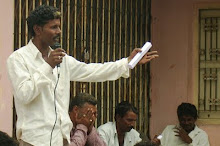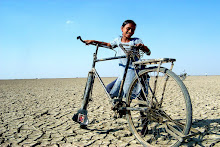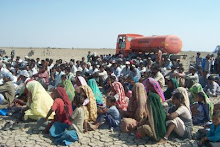Counterview: Ahmedabad: Thursday,
07 November 2019
For the
last two days, block officials responsible for disaster mitigation as also
other officials are trying their level best to persuade the agariyas of the
Rann of Kutch and coastal areas to return to their villages. Four days back,
around 150 visitors to the Vaccharajpur Temple, fondly known as ‘Vacchada dada
nu mandir’, got stuck in the muddy surroundings, as their vehicles could not
move due to sudden rain.
Youths
from Zinzuwada villages came to the rescue of the devotees. Only villagers living in the periphery know the
vast expanse of the Rann thoroughly. Just by looking at the mud pattern and
humidity they can sense how safe or dangerous could it be during the day. All
the devotees were brought back safe.
Two days
later, there came the warning of Maha cyclone and heavy rainfall. The local
Sankalan Samiti, or the coordination committee, chaired by the deputy
collector, met in the presence of the local MLA, discussing several serious
issues concerning the Rann, especially hundreds of agariyas, who had already
already moved to the Rann for salt cultivation.
No
doubt, rainfall at the start of the season usually saves some amount they spend
on diesel, which they require to pump out water to make bunds for saltpans and
level the beds of the saltpans. This earthen work continues for a month, after
which agariyas pour water into saltpans in order to cultivate salt.
“One
barrel of crude oil/diesel is saved if we get rain water during this time”,
said Keshubhai Surani, one of the salt farmers from Ghatila Rann area, pointing
towards the reason why most of the agariyas did not leave Rann despite recent
post-monsoon rain. One barrel costs around Rs 12,500, an amount which they
usually borrow from trader.
"However",
he admitted, “This time, prolonged post-monsoon rains affected us. We wouldn't
be able to cultivate crystal salt for more than six months this year.”
Traditional salt farmers of the Rann make crystal salt, called Vadagaru, or
Poda which takes six months to take the shape of full size crystal to fetch price
of up to 24 paisa per kg.
Surani
continued, “This time rainfall continued for quite some time. The Rann got
filled up with much more water than what we required. Block officials,
activists working with the agariyas, belonging to the Agariya Heet Rakshak
Manch (AHRM), and community leaders had to work overtime to evacuate them from
the Rann.
These
agariyas had already made their makeshift huts, a temporary shelter during
their stay in the Rann . But as water levels increased, they were in a dire
straits. The whole area got flooded. It was impossible to keep their utensils,
blankets, grocery, everything, safe. They had to leave the Rann immediately.
They had to walk several kilometres through water with muddy and slippery
ground to reach their villages safe.
Their
woes did not end here. Narmada department engineers conveyed to the agariyas
that they too would release extra water into the Rann from the Narmada branch
canal. They wanted to ensure that the agariya are not trapped, hence they
contacted agariya leaders and AHRM team members.
Agariyas
told the engineers it was not a good idea to release Narmada water into the
Rann. One of the leaders told a senior Narmada engineer, “If Narmada water is
released, we will not be able to go into the Rann for another 20 days and
continue with salt cultivation.” They were not sure if Narmada officials would
listen to their plight.
Meanwhile,
water level in some parts of Santalpur and Visanagar Rann started rising. This
could happen only if water was being released from the Narmada branch canal.
One official confided to an agariya leader off the record, had they not
released it, the poorly constructed canal's safety would be at stake.
Meanwhile,
the Gujarat government announced compensation for farmers for crop damage due
to heavy rainfall this season. However, the salt producers were at a loss: They
wouldn't be getting any of it.
Rued an
agariya leader, “Each agariya has suffered huge losses. We have been
cultivating salt in Survey No Zero – as the land on which the saltpans are
situated is known -- for centuries. No doubt, the government has reaches us
with water supply, education, mobile health van, spending huge amount for
welfare and development. But when it comes to compensation for our losses, we
do not exist”.
“If you
look at the past 10 years, every year either agariyas are at a loss due to
unseasonal rains, or due to sudden release of Narmada water. Agariyas have been
demanding compensation. Sometimes officials do conduct survey and seek details.
But no compensation is ever paid”, said Harinesh Pandya, trustee, AHRM, which
has been working with the agariya community for the last 15 years.
“On one
hand, despite salt farming for decades and centuries, they are deprived of
their land use rights under the Forest Rights Act (FRA). On the other, they are
excluded from any protection mechanism like compensation or insurance cover. How
can the state behave like this? Why can’t it come up with a fair policy to
protect salt farmers? After all they contribute 1/5th of the total salt
produced in Gujarat,” he added.
The
present and the future of over 8,000 agariya families from nearly 110 villages
of Surendranagar, Patan, Morbi and Kutch districts is at stake. Nature and
government both are unkind to agariyas, leaving them at the receiving end.
















.jpg)
.jpg)
.jpg)
.jpg)













No comments:
Post a Comment